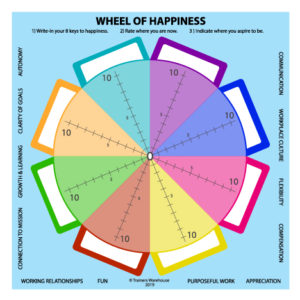The Wheel of Happiness — a personal venture
I love that scholars are studying happiness and finally understanding that success does not breed happiness; rather happiness breeds success. I learned that from my dad who long ago left the corporate world to start Trainers Warehouse. Starting a new business felt financially risky, but his happiness at work skyrocketed. I followed him and experienced the same.
Surely, studying happiness is not new. Positive Psychology, “the scientific study of what makes life most worth living,” cropped up in the mid-1950s. Then, in the late 1980s, Mihaly Czikszentmihalyi started talking about the Science of Happiness. Still, systematically understanding what contributes to individual happiness is a relatively young field. While some experts might come up with a list of 10 Keys to Happiness, the same 10 factors may not be critical to every person’s well-being and the way they weigh those factors may also differ.
What makes YOU happy?
To help others maximize their happiness, our Trainers Warehouse team developed The Wheel of Happiness assessment (an extrapolation from Paul J. Meyer’s Wheel of Life®). This simple worksheet allows coaches, facilitators, trainers, and team leaders to help individuals identify the key drivers of their personal happiness, at home or at work. Once they hone in on WHAT makes them happy, follow-up questions can focus on how happy they are now and what would make them happier, along each of those metrics.
For some, feeling happy may be a function of career, friendships, health, physical well-being, and finances. Others may be more focused on finding purpose, personal growth, or having ample “me time.” With this versatile tool, managers and coaches can invite each team member to write-in the dimensions of their happiness. Alternatively, they can concentrate on specific dimensions of happiness, to uncover organizational or personal challenges.
No matter which methodology is used, the first step for every person is to think about those top eight dimensions that drive their happiness and contribute to their feeling of well-being.
Where are you now?
My Aunt Alene always used to ask us, “on a scale of 1 to 10… How happy are you? Or, do you like school? How close are you to your best friend?” You get the picture. Everything was on a scale of 1 to 10. Since then, it’s become a family thing. Taking a page from my aunt’s book of tricks, we ask team members to indicate, on a scale of 1 to 10, their current satisfaction level on those 8 key dimensions, where 1 indicates unhappiness and 10 means they couldn’t be more fulfilled.
What would make it a 10?
Assuming the goal was always a 10 (which may not always be the case), Aunt Alene’s follow-up question was always, “And what would it take to get to a 10?”
For managers and team leaders, the goal is usually to gain insight and start a conversation. Once the drivers of happiness are identified and current happiness levels charted, they can ask their group, “How can we do better? What can we do personally or organizationally to make you more content and make our office a happier place?”
As we’ve used the tool internally at Trainers Warehouse, we’ve found that not all dimensions of happiness are created equal. For instance, I might rank FUN as a 7 in terms my current happiness level, but truly I’m satisfied with that. On the other hand, I might measure my CONNECTIONS WITH COLLEAGUES at a 6, in terms of my current happiness, but here I aspire to a 10. My mission, then, is to come up with a list of ways that I can build stronger and more fulfilling connections with my co-workers.
Flexible by design
The Wheel of Happiness is flexible on purpose. Managers at work may want to explore different dimensions of happiness than a life coach might. Talking about romance and health within the context of work may simply be inappropriate and unrelated to happiness and engagement at work. Thus, no matter which keys may drive the Wheel of Happiness, the most important is balance and the ability to use the tool as a vehicle for understanding, discussion, and improvement.
Becoming happier
Even after we’ve done all the work at identifying happiness drivers, understanding where we are, where we hope to be, and how to get there, each individual is ultimately still responsible for their own happiness. As Abe Lincoln said,
“Folks are usually about as happy as they make their minds up to be.”
―
Hopefully, the Wheel of Happiness tool, will help individuals and teams find the keys to make their lives a little happier.
Read More…
- How Happiness Leads to Success
- For information on the Wheel of Life, visit Mindtools.



This is awesome! It makes great sense. I suppose if the wheel is used with a group of salesman or managers, I can change as many of the factors to reflect the makeup of the group?
Ruth, Absolutely. It was our hope to create a tool that you could customized to the individuals or team with whom you work. I hope it works well for you! ~ Sue